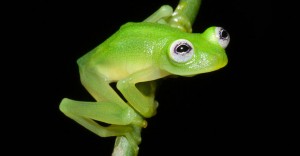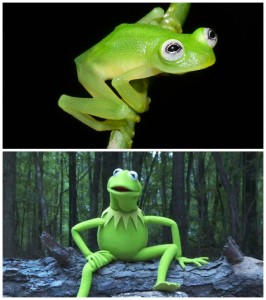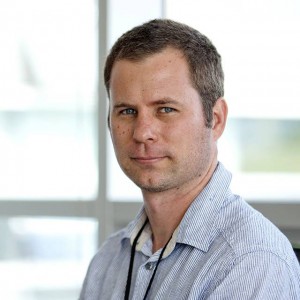Alumnus Robert Puschendorf part of research team that discovered new species of “Kermit” frog
EARTH graduate Robert Puschendorf (’98, Costa Rica) was part of the research team (along with Brian Kubicki and Stanley Salazar) that discovered a new species of glass frog in the Costa Rican provinces of Heredia and Limón. The scientists named it Hyalinobatrachium dianae in honor of Brian’s mother and the Roman goddess of the hunt, Diana.
This tiny amphibian, which measures less than an inch long and has bright green skin and large white irises, has been making headlines around the world for its uncanny resemblance to Kermit the Frog from the Muppets.
We got a chance to talk to Robert and he answered our questions about his experience:
How did you found out that this was a brand new species of frog?Brian [Kubicki] and Stanley [Salazar] discovered the frog, but because it is very similar in color and shape to its sister species, they sent me a tissue sample to be sure. It wasn’t until I ran some molecular tests that I told them to start paying attention. It was evident we were looking at a new and beautiful discovery.
How did the research get started?
My two colleagues started the investigation in the field, and then it was lab work and more fieldwork to really be able to describe and understand the biology of the species.
What was your contribution to the research?
It was limited to laboratory and manuscript. I must confess I haven’t had the pleasure of meeting the frog outside of the lab. I usually work in other areas of Costa Rica, and my participation in this research began because of my friendship with Brian.
Are you going to keep doing researching on this frog? To understand for example, how it might be affected by climate change?
That’s actually one of my lines of research, specifically the interaction among diseases, climate change and extinction. It’s kind of sad, but I focus on the species that survive and try to understand how they do it. Luckily, glass frogs are very resistant to known diseases and are one of the few species that are still alive in zones where other already disappeared.
What do you think about the comparison with “Kermit” from the Muppets and all the exposition it got?
Well, the comparison made the frog famous, and I would like to clarify that this didn’t came from us- in fact, I’m still not completely clear where did it came from. A lucky break maybe?
How did you find out about EARTH and what encouraged you to study here?
Well, I knew I couldn’t live behind a desk and EARTH caught my attention. At that time, it seemed like the path I wanted to take. Definitely my passions are biology and research. EARTH has a strong scientific foundation, which helped me realize how much I liked fieldwork, and I had the opportunity to do my thesis with Ph.Ds Kohlmann and Russo, which allowed me to explore biology and amphibians.
How did EARTH influence your life?
It opened my eyes to the realities of our planet and fed my passion for science. But it also confirmed for me that what I wanted to do was biology, which is why I completed a Master’s after graduating. I have very beautiful memories from my time at EARTH and I maintain friendships with classmates and professors to this day. EARTH is still a mandatory visit when I’m in the region.
What have you done since graduating from EARTH University?
I followed a bit in the steps of [EARTH professor] Dr. Bert Kohlmann; I got a Master’s degree in Zoology from the University of Costa Rica and went to Australia, where I earned a Ph.D and a fellowship from the Australian Research Council. Finally, as it happens in life, I got married and ended up living in England, my wife’s home country. I’m a professor here at Plymouth University. This change has allowed me to work once again in Costa Rica; Australia is spectacular, but it is almost impossible to work in my country because of the distance and travel costs.







